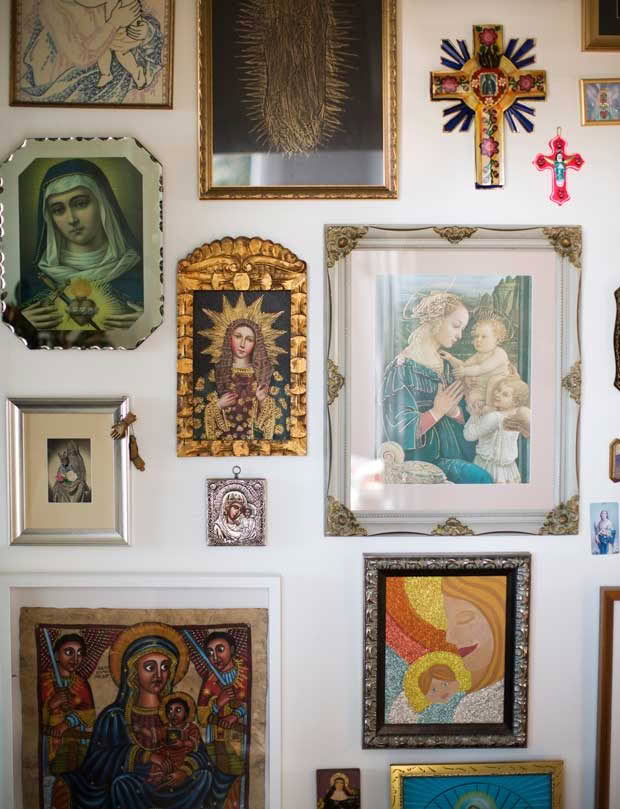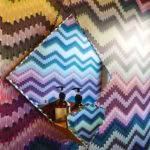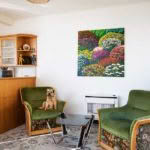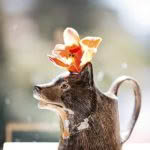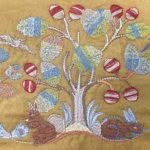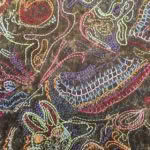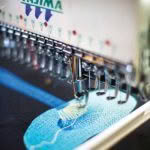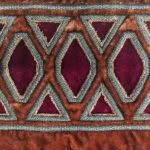Madonna and St Fabiola (the patron saint of divorce) inspire Kelburn digital textile artist Kirsten Sutherland
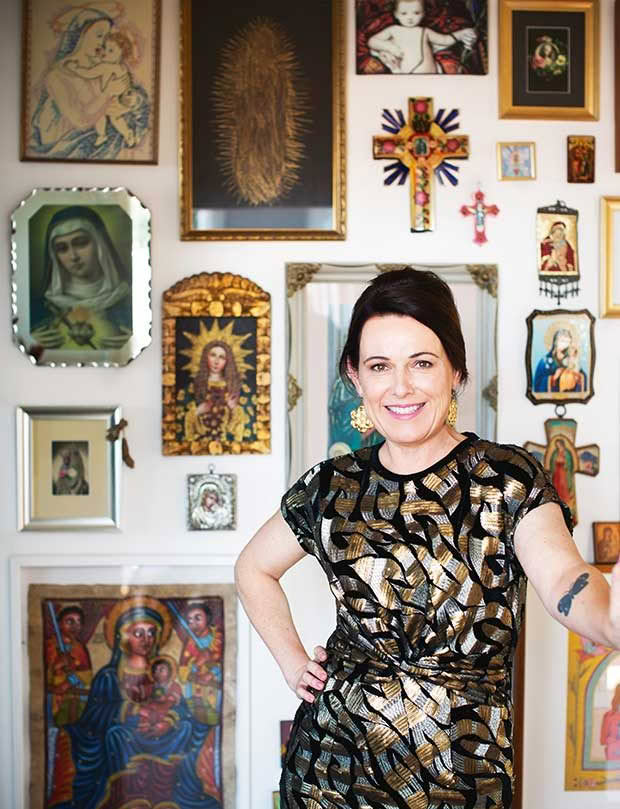
Kirsten surrounds herself with saints. From the many madonnas to her business namesake, St Fabiola, the textile artist always has been drawn to religious iconography. “I’ve collected the various madonnas over my lifetime. My favourite is the African madonna from Ethiopia, painted on vellum.” (This work is at the bottom left of the photograph opposite, by Kirsten’s elbow.)
Wellington digital textile artist Kirsten Sutherland has stitched together her art, an eclectic home, a creative boutique and a new husband, who just happens to own a brewery.
Words: Lee-Anne Duncan Photos: Tessa Chrisp
She’s into Madonna, Kirsten Sutherland. Whether it’s the Queen of Pop with her conical bra or Our Lady in her blue robes, the Wellington textile artist and boutique owner is a big fan. Naturally, as a child of the 1980s, she remains partial to Madonna’s music but it’s fair to say the more saintly one has had a greater impact. Inside Kirsten’s Kelburn villa there are many madonnas; painted and stitched or formed in porcelain or glass. It’s quite the pantheon for someone brought up a questioning Catholic but is now not so church-going.
It wasn’t until she had her children – Grace (17) and Freda (14) – that Kirsten felt an affinity for the mother of Jesus. “I was quite shocked at how much status and confidence you can lose when you become a mother. Mary made so much sense as an icon to look up to as a mother – she has so much status.”
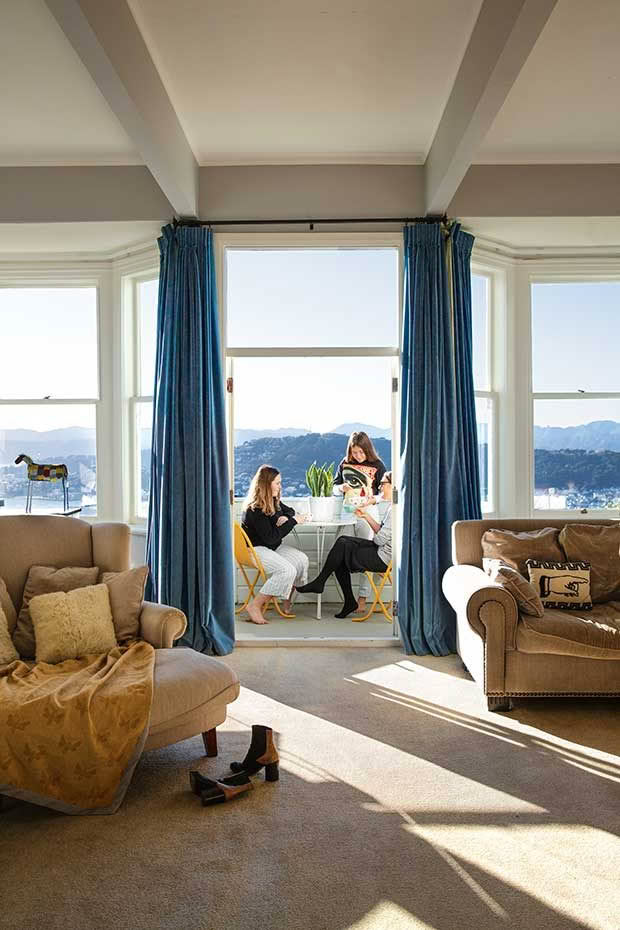
Kirsten’s Kelburn villa in Wellington’s dress circle means an outside brunch is a must on those nothing-beats-Wellington good days. Kirsten lives with daughters Grace and Freda Chatwin and new husband Bruce Turner (when he’s not brewing).
That was the early 2000s, and Kirsten was living in Queenstown with her first husband. She started accepting commissions from Queenstown women, generally portraying them as the Madonna (note the definite article). “I was doing it all on a sewing machine, using a mixture of appliqué, silk, old doilies and cut-up clothes. “I was also inspired by the New Zealand artists who were using religious imagery, such as Colin McCahon and his The Virgin and Child Compared – that painting is amazing. I loved the artists’ interpretation of Catholic symbolism. It was also quite a thing in Dunedin when I was growing up. It was the Gothic era so religious symbolism was all around us — all slightly subversive.”
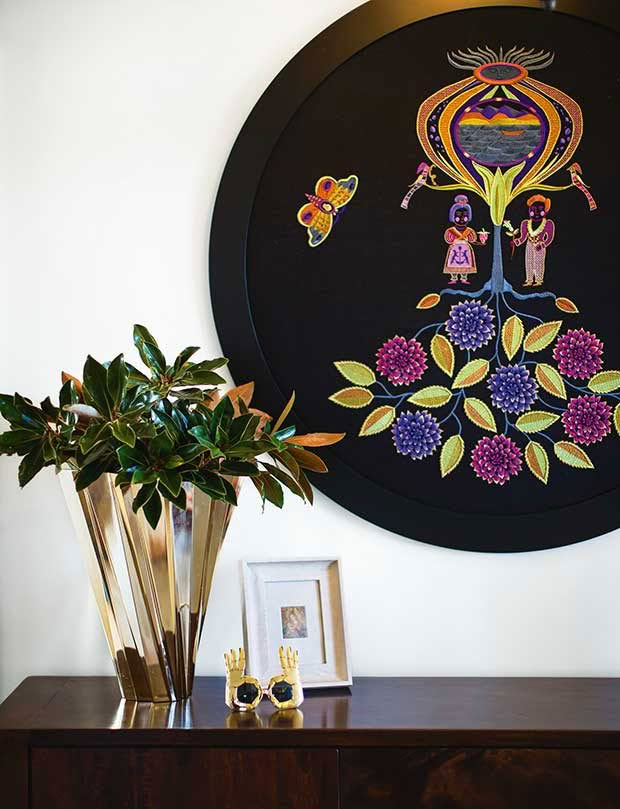
After a move to Wellington in 2007, Kirsten enrolled at Massey University for her Master of Design degree, specializing in digital embroidery. For it, she created a series of religiously themed embroidered portraits. (Including one of NZ Life & Leisure photographer Tessa Chrisp.)
“I was already working as a technician for Massey’s textiles programme and that year the university brought a digital embroidery machine into the department. It was my job to learn to use it, so it was obvious to make my master’s about the machine. “I was focusing on ecclesiastical embroidery and the idea that the nuns would sit and stitch during mediation, like a prayer, and that objects could be imbued with holy powers.
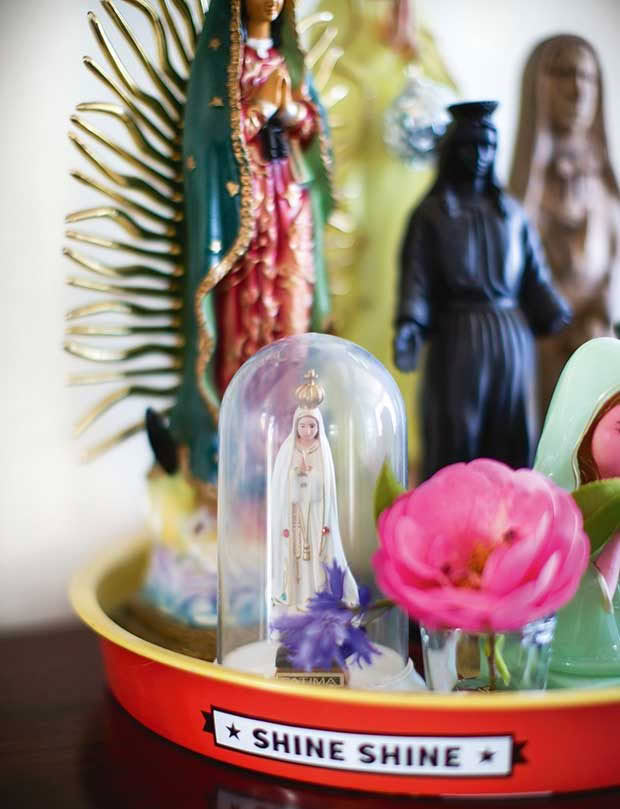
“The course director was very unhappy with me doing anything about religion but I was happy to be the rebel if that’s what it was. I had an almost spiritual journey myself learning to use the machine. I now have my own machine, which I call Baby. I have been very, very in love with that machine.”
While Kirsten mostly now uses Baby – which can make 850 stitches a minute with its 15 needles threaded in 15 different colours – to create her embroidered art, she came to her art form the old-fashioned way. “My grandmother taught me to embroider and my high school – Otago Girls – offered it as a subject.”
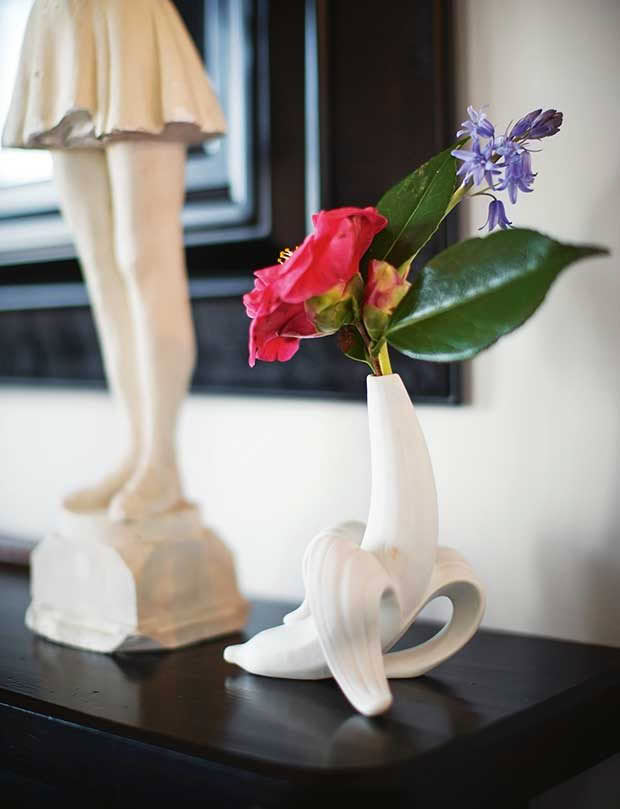
That needlework cast Kirsten into the art world. High school finished, she went to work for arts identity Marshall Seifert at his Dunedin gallery. “It was like an apprenticeship. It was amazing and Marshall taught me a lot. I was only 19 and was organizing exhibitions, curating – I had a lot of responsibility for one so young. I read all the books in the gallery, learning heaps about New Zealand art.
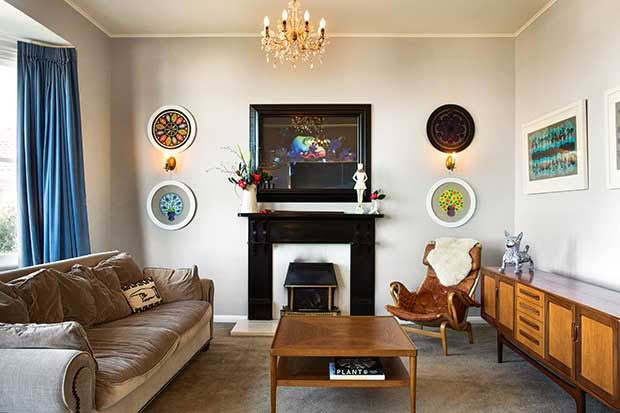
Her living room features her art, Fiona Pardington (above the mantle), a laughing ceramic dog by Jim Cooper, and — on the mantle — a tiny vase shaped like a peeled banana from Jonathan Adler in New York. “The ceramic lady is an Otago School of Art sculpture exercise from 1930s that I found in a Milton op shop.”
“Finally, I realized I needed to do it myself so I went to the Wellington School of Design meaning to do graphic design but ending up in textiles.” Her degree complete and on her OE in Britain, Kirsten worked in the Room of Luxury at Harrods in London and the couture room at Harvey Nichols.
“I met so many celebrities: David Beckham, Joan Collins – she was cool – Cate Blanchett, Enya, Shirley Bassey. I read all the magazines, so I was good at recognizing famous people.” The two jobs taught her a lot about luxe – and dealing with customers. “We had to wear black suits, low court heels, nude pantyhose and at least five items of make-up. We were lined up and inspected each morning. It was amazing because I learned a level of service and how to engage with people without being intimidated.
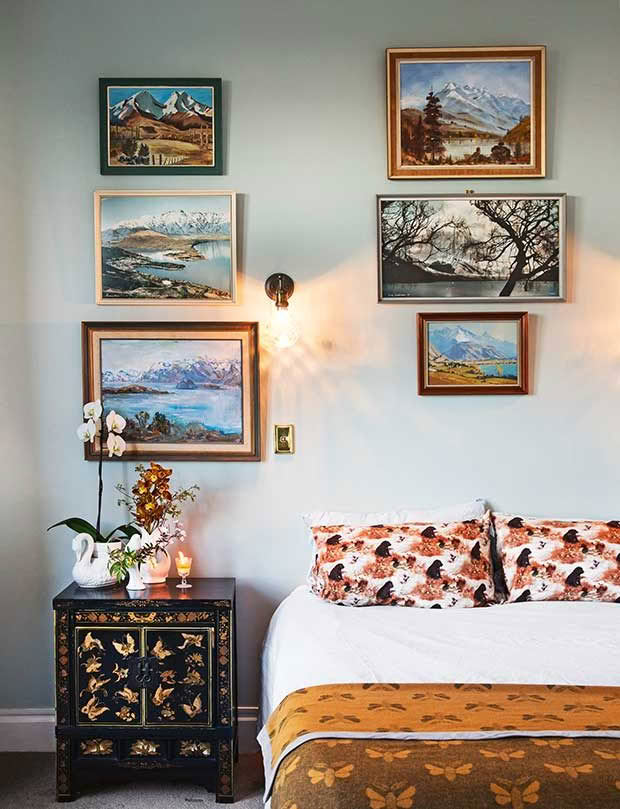
The artworks above Kirsten’s bed are all amateur paintings and photographs of Central Otago’s landscape. “My ancestors were goldminers and Central Otago is my spiritual homeland,” she says.
“I got very badly told off by a Saudi princess once for saying hello to another customer – Sting’s wife, Trudie Styler – while I was helping her. The princess lost the plot, had me in tears, and complained to management. But my boss told me not to worry about it. They were so strict about everything, including how garments were hung and placed. Things like leaving a security tag on meant instant dismissal.”
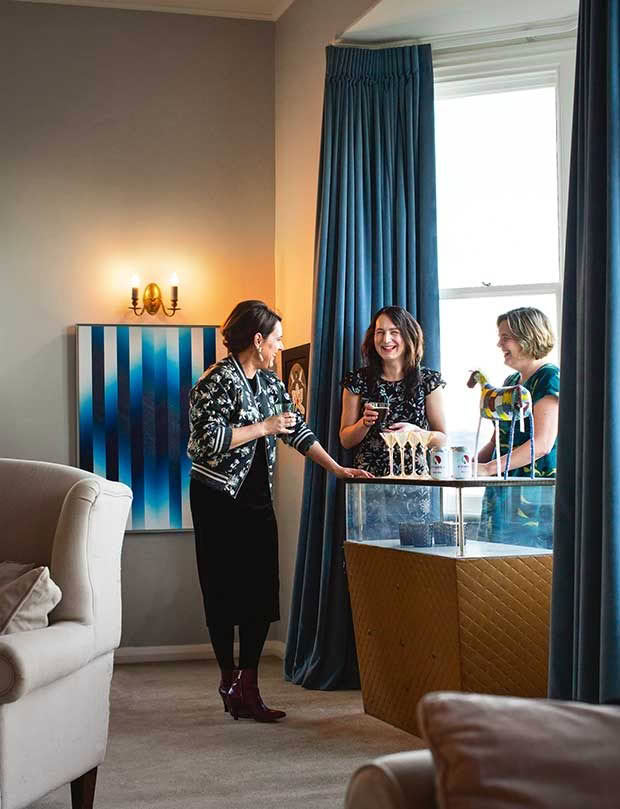
Holly Sutherland and Anna Sutherland, enjoy a cocktail with the best view in Wellington.
While Kirsten’s Wellington shop is not that kind of ship, her boutique in the city’s newly revamped Lombard Lane is easy on the eye. It’s also saint-associated, like her home, although this time it’s named for St Fabiola, not Lady Madonna.St Fabiola, the patron saint of divorce (yes, there is one), and nurses and abused women, has always fascinated her.
“There was an image of her by [French painter] Jean-Jacques Henner that was copied endlessly in the 1930s and 1940s. Lots of people have this image of her in their houses because it looks cool without knowing what it means or who she was. (St Fabiola, a Roman Christian of the 4th century BC divorced her violent husband and took up with another man, which was acceptable under Roman law but not under Christian.) “I was shown an exhibition of Francis Alÿs who had collected about 500 copies of the Henner image of St Fabiola, all created in different ways. It was fascinating. I just loved the name, and then I got divorced, so I made St Fabiola my business name.”
- The Timorous Beasties wallpaper in Kirsten’s upstairs bathroom is hand-printed in chevrons made up of tiny moths, her favourite insect.
- In the kitchen/sitting area a painting by Karl Maughan — a near neighbour — hangs above border terrier Zigi (indeed, named for David Bowie).
- The little wolf jug/vase from Iko Iko was a present from Grace and Freda.
Kirsten is also a business partner in Hailwood, the fashion label of her friend Adrian Hailwood, and she runs the designer’s production and sales. Hailwood’s collections feature in her shop along with New Zealand art, including Kirsten’s pieces, and some from photographer Fiona Pardington and New York-based painter Martin Basher, originally from Wellington.“The idea for the boutique started because Adrian needed a Wellington outlet for his designs and I wanted a platform for my work. I also knew I wasn’t making enough money teaching textiles, and my embroidering work for films was all over the show. I thought I could start a gallery, just a little shop to put my things in, and maybe a few interiors pieces. But then the Stark White Gallery asked me to be the agent for Fiona and Martin so it all got bigger and bigger.”
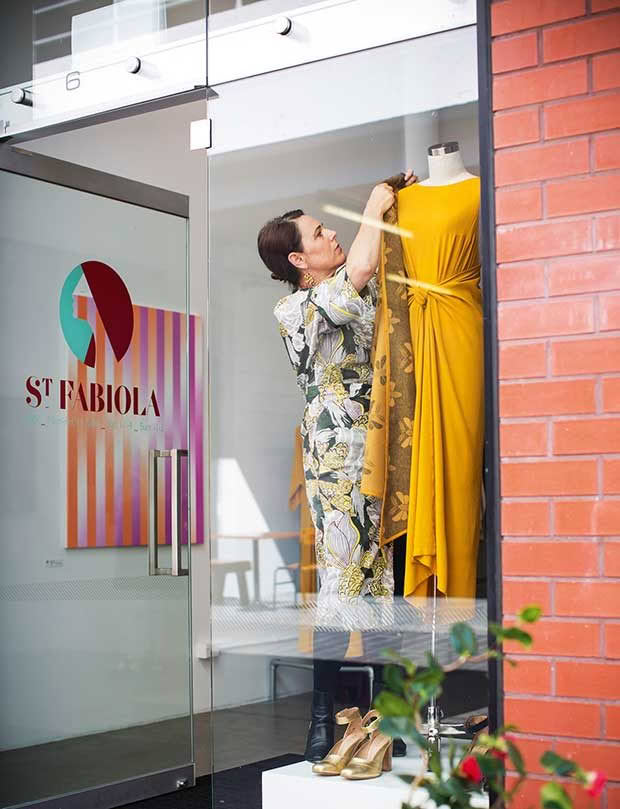
In the window of her Wellington boutique, St Fabiola, Kirsten adjusts a Hailwood dress. A Martin Basher painting is in the background.
At the same time, Kirsten’s then-boyfriend-now-husband Bruce Turner was setting up his Auckland brewery, Urbanaut. “I was seeing Bruce making a go of his business. And because he spends most of the working week in Auckland with me down in Wellington with my daughters, it was quite lonely in the days I wasn’t seeing him. So, I decided it was time to really focus on something and set up my business as he was setting up his. He was positive and helpful. The girls were too.”
Kirsten also received helpful advice regarding the set-up. “Don’t spend money on the fit-out as no one notices as long as the shop is nice and neat — spend money on products and beautiful things to sell. That was the best advice — I was about to spend $10,000 on lights and $4000 on a beautiful counter. Instead I spent $800 on lights and $250 on a counter.” It helped, too, that before becoming a brewer Bruce was an industrial engineer and handily constructed her racks and other fittings.
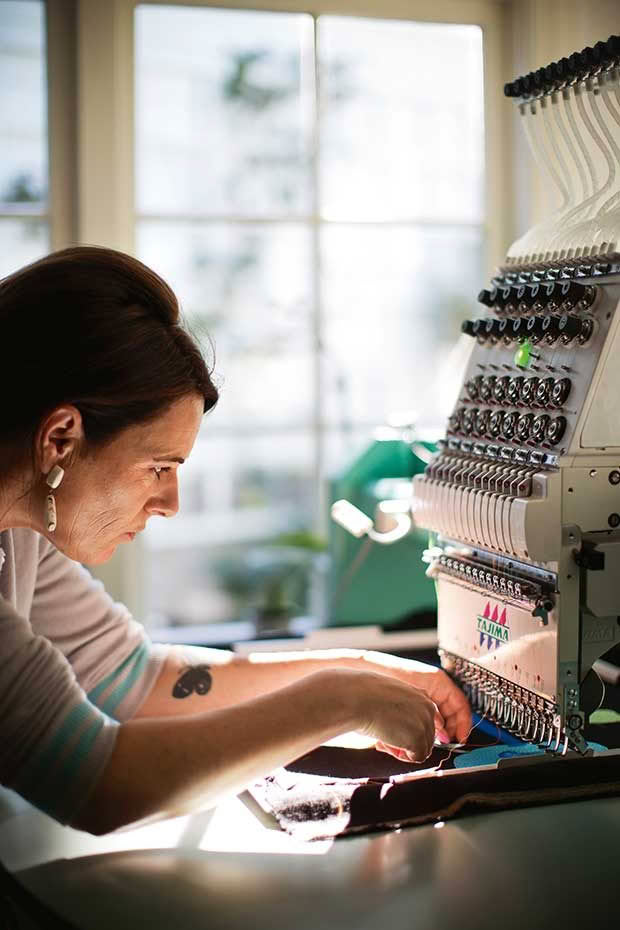
Kirsten, who learned embroidery from her grandmother, was drawn to textiles when studying for her design degree. While teaching textiles at Massey University (Wellington), and starting her master’s, she had to learn to use a digital embroidery machine. She fell in love with the art form, eventually investing in her own machine.
Up and running, it’s been a steep learning curve as she masters retail. “I’ve had to learn how to import products from China. I now know how to sort an import licence, get foreign exchange sorted, have all the necessary freight and customs clearances. I’ve had to create communication channels with suppliers. I’ve learned to create and run distribution systems. “But the biggest business lesson is that you need a real balance between determination and the ability to go with the flow. You must let things happen and not let disappointments pull you down. You just need to ride them.”
ART SEWN UP
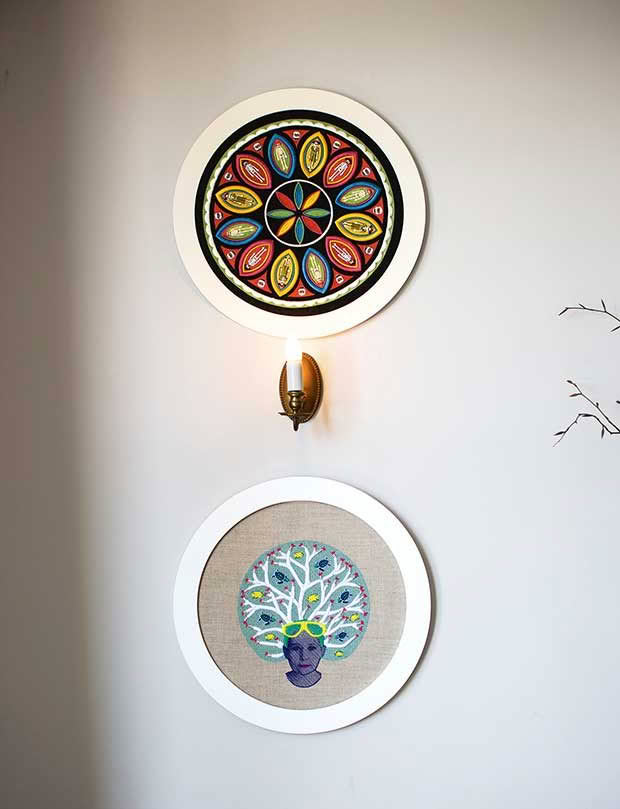
For her artworks, Kirsten first sketches the image and colours she wants on paper. Then she scans the images into her computer, putting it through Stylista software. “Using the software, I select which stitches fill each section and the direction the stitches go. You can have 15 different needles threaded with 15 colours and you need to work out which colours go first as the colours layer over the top of each other, like a lino-cut print. It’s quite techy.”
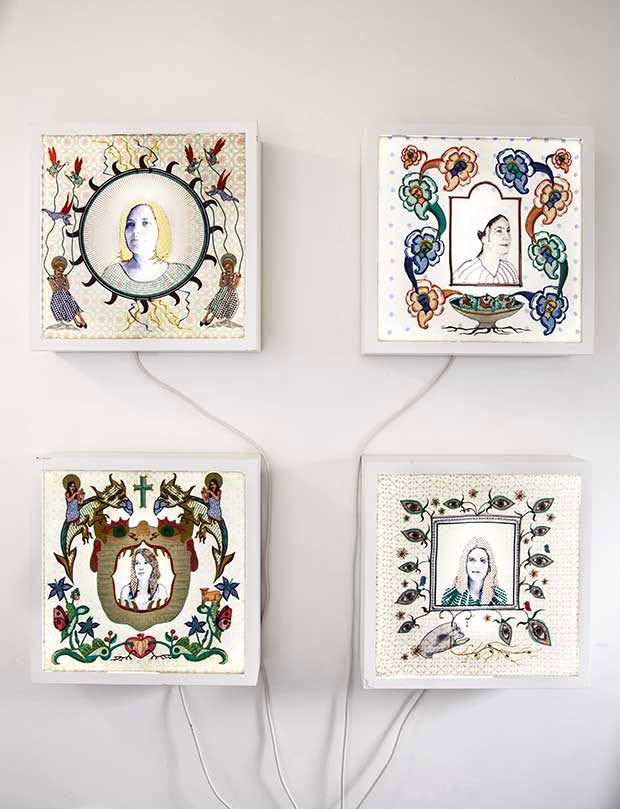
Similar to any baby, Baby the machine needs to be watched to make sure she stays out of trouble. “Some angles will make it cut out and I’ll need to re-thread it, so I can’t just walk away. “Again, depending on the design, about four hours after it starts, stitching at 850 stitches a minute, the artwork is done. That’s substantially quicker than the 60 or more hours most designs might take to hand-embroider.” stfabiola.co.nz
BABY AND THE HOBBIT
Digital embroidery machines don’t come cheap. The Tajima machine from Japan that Kirsten calls Baby set her back about $36,000. But the investment was worth it to have her own machine to use for her art, and lucrative — if erratic — film work. Besides creating her own designs, Kirsten has been in demand to embroider costumes and props for films, including The Hobbit series.
“The day after I finished my master’s in 2010, I rang a friend working on The Hobbit to ask if they needed embroidery. She said, ‘Can you come in tomorrow?’ They gave me a sample to do and I took it back in two hours. They were like, ‘Right, you’re starting now.’
While the production also used hand-embroiderers, Kirsten was the only machine embroider, creating beauty on the collars and edges of all the dwarves’ tunics, cloaks and leather gloves. “Orlando Bloom as Legolas had a leather jerkin with a dongle with embroidered edges. And Stephen Fry had amazing embroidered boots you don’t even see. I probably did 1000 garments. That was a full-on 18 months.”
LOMBARD LANE
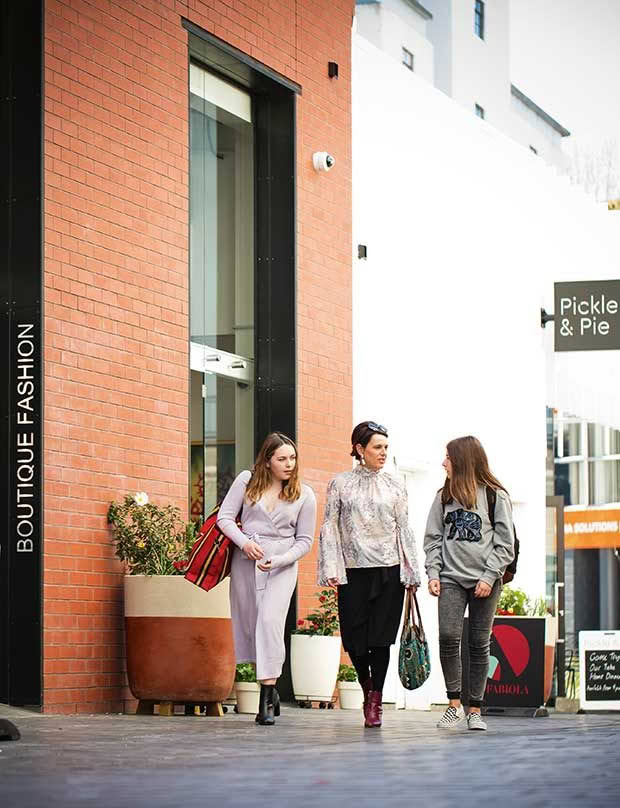
The latest in the move to jazz up Wellington’s streets, Lombard Lane has been transformed from a slightly seedy side street to a chic shopping destination. Lombard Lane — which runs between Bond and Manners Streets — features the New York-style deli, Pickle and Pie, café Lamason, fashion designer Deryn Schmidt, gin bar and distillery Denzien, St Fabiola and other retailers yet to come. “There’s always the issue of getting foot traffic through, but it’s going to be a cool little community that will develop over time,” says Kirsten.
URBANAUT’S THIRSTY KIRSTY

Kirsten married Bruce Turner in his Auckland brewery and tasting room in February this year. To celebrate, Bruce brewed a champagne pilsner he called Thirsty Kirsty. “We went through quite a number of kegs at the wedding,” Bruce says.
Urbanaut, which Bruce owns with two schoolmates, Simon Watson and Thomas Rowe, has six core beers with a new offering every month to feed consumers’ taste for something new. “Summer is pilsner and sour beer season, and because the champagne pilsner did so well at our wedding, I thought I’d re-brew it for release in November,” Bruce says.
“It’s a stronger-than-usual pilsner with champagne yeast added at the end to finish off the remaining sugar. The champagne yeast imparts a white wine-like flavour in a dry, highly carbonated, champagne-like beer,” he says.
This time Kirsten doesn’t get naming rights – the beer’s sold as Le Marais Champagne Pilsner.
Love this story? Subscribe now!
 This article first appeared in NZ Life & Leisure Magazine.
This article first appeared in NZ Life & Leisure Magazine.
